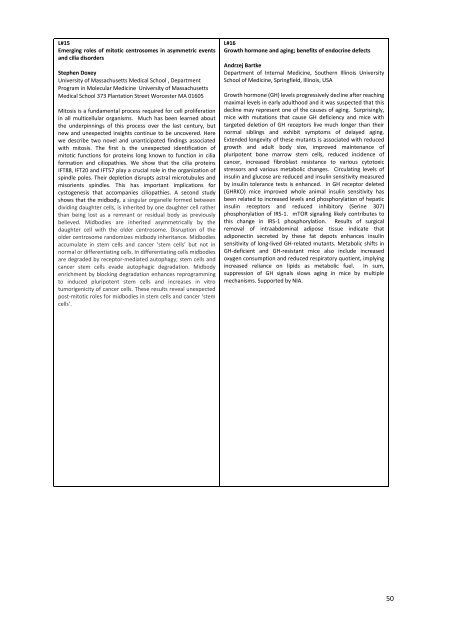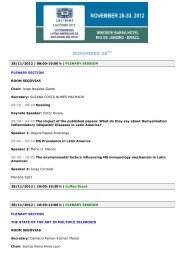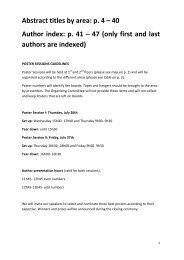Keynote Conference - Interevent
Keynote Conference - Interevent
Keynote Conference - Interevent
You also want an ePaper? Increase the reach of your titles
YUMPU automatically turns print PDFs into web optimized ePapers that Google loves.
L#15<br />
Emerging roles of mitotic centrosomes in asymmetric events<br />
and cilia disorders<br />
Stephen Doxey<br />
University of Massachusetts Medical School , Department<br />
Program in Molecular Medicine University of Massachusetts<br />
Medical School 373 Plantation Street Worcester MA 01605<br />
Mitosis is a fundamental process required for cell proliferation<br />
in all multicellular organisms. Much has been learned about<br />
the underpinnings of this process over the last century, but<br />
new and unexpected insights continue to be uncovered. Here<br />
we describe two novel and unanticipated findings associated<br />
with mitosis. The first is the unexpected identification of<br />
mitotic functions for proteins long known to function in cilia<br />
formation and ciliopathies. We show that the cilia proteins<br />
IFT88, IFT20 and IFT57 play a crucial role in the organization of<br />
spindle poles. Their depletion disrupts astral microtubules and<br />
misorients spindles. This has important implications for<br />
cystogenesis that accompanies ciliopathies. A second study<br />
shows that the midbody, a singular organelle formed between<br />
dividing daughter cells, is inherited by one daughter cell rather<br />
than being lost as a remnant or residual body as previously<br />
believed. Midbodies are inherited asymmetrically by the<br />
daughter cell with the older centrosome. Disruption of the<br />
older centrosome randomizes midbody inheritance. Midbodies<br />
accumulate in stem cells and cancer ‘stem cells’ but not in<br />
normal or differentiating cells. In differentiating cells midbodies<br />
are degraded by receptor-mediated autophagy; stem cells and<br />
cancer stem cells evade autophagic degradation. Midbody<br />
enrichment by blocking degradation enhances reprogramming<br />
to induced pluripotent stem cells and increases in vitro<br />
tumorigenicity of cancer cells. These results reveal unexpected<br />
post-mitotic roles for midbodies in stem cells and cancer ‘stem<br />
cells’.<br />
L#16<br />
Growth hormone and aging; benefits of endocrine defects<br />
Andrzej Bartke<br />
Department of Internal Medicine, Southern Illinois University<br />
School of Medicine, Springfield, Illinois, USA<br />
Growth hormone (GH) levels progressively decline after reaching<br />
maximal levels in early adulthood and it was suspected that this<br />
decline may represent one of the causes of aging. Surprisingly,<br />
mice with mutations that cause GH deficiency and mice with<br />
targeted deletion of GH receptors live much longer than their<br />
normal siblings and exhibit symptoms of delayed aging.<br />
Extended longevity of these mutants is associated with reduced<br />
growth and adult body size, improved maintenance of<br />
pluripotent bone marrow stem cells, reduced incidence of<br />
cancer, increased fibroblast resistance to various cytotoxic<br />
stressors and various metabolic changes. Circulating levels of<br />
insulin and glucose are reduced and insulin sensitivity measured<br />
by insulin tolerance tests is enhanced. In GH receptor deleted<br />
(GHRKO) mice improved whole animal insulin sensitivity has<br />
been related to increased levels and phosphorylation of hepatic<br />
insulin receptors and reduced inhibitory (Serine 307)<br />
phosphorylation of IRS-1. mTOR signaling likely contributes to<br />
this change in IRS-1 phosphorylation. Results of surgical<br />
removal of intraabdominal adipose tissue indicate that<br />
adiponectin secreted by these fat depots enhances insulin<br />
sensitivity of long-lived GH-related mutants. Metabolic shifts in<br />
GH-deficient and GH-resistant mice also include increased<br />
oxygen consumption and reduced respiratory quotient, implying<br />
increased reliance on lipids as metabolic fuel. In sum,<br />
suppression of GH signals slows aging in mice by multiple<br />
mechanisms. Supported by NIA.<br />
50





